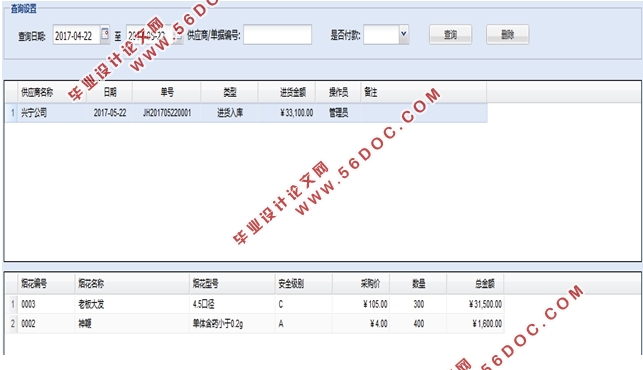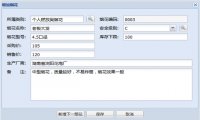烟花爆竹经销商进销存管理系统的设计(SSH,MySQL)(任务书,开题报告,论文说明书11000字,程序代码,MySQL数据库)
摘 要
从古至今,烟花爆竹都是传统节日和婚丧嫁娶等事宜中必不可少的组成部分。
由于经济的高速发展以及信息技术的不断提高,传统的人工管理烟花爆竹供应链的方式已经被经销商们所放弃,取而代之的是高存储,高速度,低成本的信息系统。本文主要研究的基本内容室基于J2EE的烟花爆竹经销商供销存系统的设计与开发。
本文研究的系统是一套基于供应链的管理,以烟花爆竹烟花爆竹经销商的业务逻辑为背景,以供应商,仓储和客户为三大主线设计开发,最终实现高效化信息化管理目的信息系统。
本文以生命周期法展开,按照系统分析,系统设计,系统实施再到系统测试的顺序对系统开发的过程进行了详细阐述。
关键词:信息系统;J2EE;进销存
Abstract
Since ancient times, fireworks are traditional festivals and weddings and funerals and other matters in the indispensable part.Due to the rapid economic development and the continuous improvement of information technology, the traditional way of manually managing the fireworks supply chain has been abandoned by the dealers, replaced by high storage, high speed, low cost information system. This article mainly studies the basic content of the room based on J2EE fireworks SCM system design and development.
This paper is a set of management based on supply chain, with fireworks and firecrackers dealer business logic as the background, to suppliers, warehousing and customers for the three main design and development, and ultimately achieve efficient management of information management information system.
In this paper, the process of system development is described in detail according to the order of system analysis, system design, system implementation and system test.
Key Words:information system;J2EE;SCM
本文的主要研究内容与结构
本文研究的烟花爆竹经销商的进销存系统是基于javaWeb技术的B/S模式的信息系统,帮助经销商实现烟花爆竹的库存,销售等业务的信息化管理,统计分析各项数据,提高效率,降低成本。
本文主要依据软件开发的声明周期法对该系统的开发过程进行描述,主要分为几个部分:
第一章绪论:主要阐述了本文的研究背景,研究意义,行业发展现状以及开发本系统的可行性和必要性。
第二章系统分析:通过一系列的沟通得到系统的需求,然后分析了该公司的组织机构,对使用该系统的成员进行了职能分析,对总体和部分业务流程进行了的分析,最后对系统的数据流程进行了分析,主要完成了数据流程图以及数据字典。
第三章系统设计:首先对该系统进行模块上的划分,对各模块进行功能上的设计,再进行数据库的设计,包括表结构的设计以及逻辑模型设计。
第四章系统实施:先介绍一下开发该系统所使用的技术和开发工具,以及阐述一下系统测试。



目 录
摘 要 I
Abstract II
第1章 绪论 1
1.1 课题研究的背景和意义 1
1.1.1研究背景 1
1.1.2研究意义 1
1.2 国内外的发展现状 2
1.2.1国外发展状况 2
1.2.2国内发展状况 2
1.3本文的主要研究内容与结构 2
第2章 系统分析 4
2.1分析背景 4
2.2进销存系统总体分析 4
2.3功能性需求 5
2.4组织结构与职能分析 6
2.5业务流程分析 7
2.6数据流程分析 8
2.6.1 数据流程图 8
2.6.2 数据字典 11
第3章 系统设计 14
3.1系统总体模块划分 14
3.2子功能模块设计 14
3.3数据库设计 15
3.3.1逻辑模型设计 16
3.3.2表结构设计 18
3.4输入输出设计 21
3.5开发架构的设计 22
第4章 系统实施 23
4.1系统实现的若干关键技术 23
4.1.1 struts2框架 23
4.1.2 spring框架 23
4.1.3 hibernate框架 24
4.2系统开发环境和开发工具的选择 24
4.3系统测试 25
结束语 26
参考文献 27
致 谢 28
|







